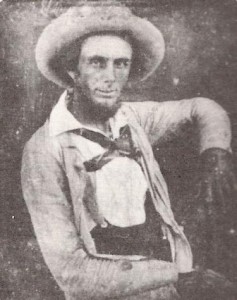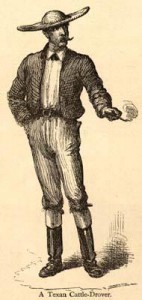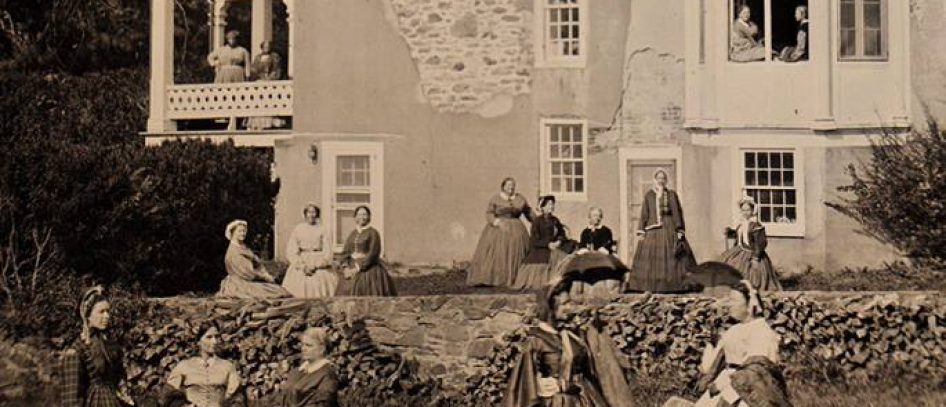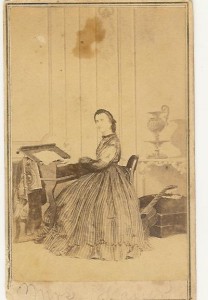 There are several period descriptions of the “typical” Texan. They have been described as “‘renegade Americans,’…‘refugees from justice’ many of them, smart, shrewd and unscrupulous.”1 A Union prisoner at Camp Ford in Tyler, Texas described his captors as a “simple, half-educated people.”2 Louisiana refugee Kate Stone stated “The more we see of the people, the less we like them, and every refugee we have seen feels the same way.”3 Kittie King writing from Fort Worth in 1860 thought “it does seem to me that all that [they] do is to drink whisky and talk about killing Indians.”4 Lt. Col. Arthur J.L. Fremantle of England included Texas as part of a three month tour of the southern states in 1863. Despite the Texans “peculiar habits of hanging, shooting, etc, which seemed to be natural to people living in a wild and thinly-populated country, there was much to like in my fellow-travellers. They all had a sort of bonhommie honesty and straightforwardness, a natural courtesy and extreme good-nature, which was very agreeable.”5
There are several period descriptions of the “typical” Texan. They have been described as “‘renegade Americans,’…‘refugees from justice’ many of them, smart, shrewd and unscrupulous.”1 A Union prisoner at Camp Ford in Tyler, Texas described his captors as a “simple, half-educated people.”2 Louisiana refugee Kate Stone stated “The more we see of the people, the less we like them, and every refugee we have seen feels the same way.”3 Kittie King writing from Fort Worth in 1860 thought “it does seem to me that all that [they] do is to drink whisky and talk about killing Indians.”4 Lt. Col. Arthur J.L. Fremantle of England included Texas as part of a three month tour of the southern states in 1863. Despite the Texans “peculiar habits of hanging, shooting, etc, which seemed to be natural to people living in a wild and thinly-populated country, there was much to like in my fellow-travellers. They all had a sort of bonhommie honesty and straightforwardness, a natural courtesy and extreme good-nature, which was very agreeable.”5
Texas fashion appeared to be behind the times, at least according to Kate Stone. She apparently thought very little of Texas women and considered them somewhat backward. In 1863 she wrote “Hoops are just coming in with full fashion. This is indeed the place where hoops ‘most do flourish and abide.’ Have not seen a hoopless lady since entering the state. Shoes are considered rather luxuries than necessities and are carefully kept for state occasions….…they [hoops] are all in the fashions of three years ago. If they would only leave off their tremendous hoops, but hoops seem in the very zenith of their popularity….Nothing looks funnier than a woman walking around with an immense hoop—barefooted.”6
At a funeral, Stone describes “…one girl airy in pink tarleton and another sweltering in red woolen; high horn combs with long ribbon streamers waving from the top; immense hoops, and strand after strand of beads, all colors, wound around their necks. Many of the men were barefooted, and nearly all of their slouched wool hats were decorated with ribbons or an artificial flower. There were few coats but many vests and a display of homemade knit galluses.”7 She later mentions a church service where the women of the congregation wore “Short dresses, large hoops, and top-knotted sunbonnets…”8
 Of the men of Texas Thomas North had this to say:
Of the men of Texas Thomas North had this to say:
“The masses of them wore spurs on their heels, generally the immense wheel-spur, and though they were not born with them on, yet they might as well have been, for they not only rode in them, but walked in them, ate in them, and slept in them. Their clanking as they walked was like a man in chains. They wore belts around the waist, suspending one or two revolvers and a bowie knife; were experts in the saddle, had a reckless dare-devil look, and were always ready for whisky and a big chew of tobacco, and the handwriting of passion and appetite was all over them. They were cow-boys from the wild woods and prairies, and sons of the low class planters, with a strong sprinkling of the low white trash, clay-eaters, so plentiful in the Atlantic Southern States.”9
1 North, Thomas. Five Years in Texas: or, What You Did Not Hear During the War from January 1861 to January 1866. A Narrative of His Travels, Experiences and Observations, in Texas and Mexico. Elm Street Printing Co., Cincinnati 1871, page 68
2 Friend, Llerena B. “The Texan of 1860” Texas Vistas, Texas State Historical Assoc. 1980.
3 Anderson, John Q. Brokenburn: the Journal of Kate Stone 1861-1868. Louisiana State University Press, 1955, page 238.
4 Letter from Kittie King, 1860, Lizzie Waddill Letters, Archives and Information Services Division, Texas State Library and Archives Commission.
5 Fremantle, Lt. Col. Arthur J.L. Three Months in the Southern States. University of Nebraska Press, 1991, page 60.
6 Anderson, page 223, 225
7 Ibid page 234.
8 Ibid, page 241.
9 North, page 104.

